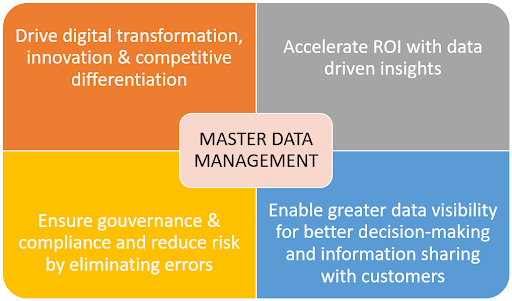Poor Data Management Strategy Can Kill your Business
Poor online data processing and management can cause widespread losses to businesses across industries, from financial to reputational. A few years back, a leading credit reporting agency, preferred by millions of people for their economic health assessment, had a lot of security lapses in their system. Upon investigation, it was detected that the attackers supposedly entered their systems and exfiltrated vast amounts of customer data. People’s personal information and their Social Security numbers were exposed due to poor data management and security. Over 143 million customers were affected by this incident, and attackers were active for around 76 days in the company’s system. The catastrophic event led to regulatory investigations and numerous lawsuits and damaged the company’s overall reputation. This case is a clear example of how poor data management strategies can cause irreparable damage to a firm!
Companies have a massive volume of data at their disposal, but many need to improve to manage data regularly, correctly, and adequately. Companies need to know what information in their database is valuable, which is obsolete, and which needs enrichment otherwise long-term success and sustainability cannot be guaranteed.
Data Processing and Data Management: How Do They Differ?
Data processing and management are closely associated terms that allow businesses to efficiently refine, sort, arrange, update, and use the researched data.
In data processing:
- Raw data is gathered and then processed to extract meaningful information.
- Professionals use various tools and techniques to drive actionable insights from this data. Experts filter, sort, summarize, and analyze the data relevant to every firm’s department. Well-processed data ensures that the raw data, finally refined in the process, is appropriate, helpful, and accurate.
In data management:
- Cleaned and processed data is arranged, stored, updated, and maintained throughout its lifecycle.
- Data management focuses on enhancing the credibility, quality, and security of all organizational activities that rely on data. A company’s strategies, policies, operations, and long-term goals depend on the results yielded from this well-managed data.
How Can Poor Data Processing and Management Harm your Business?
| Risks of poor data processing | Risks of poor data management |
1. Excess of duplicate and redundant data:Poorly processed data is bound to have duplicate, unwanted, and unreliable information from various sources. Data researched from multiple primary or secondary sources needs proper cleansing, scanning, and indexing before it is put to final use. This can ultimately lead to confusion, errors, extended deadlines, and lack of reliability on the data. |
1. Loss of customer belief:Maintaining sensitive customer data like their signup, login, payment, or location details is one of the most critical responsibilities of every business. Poor data management can lead to breaches that will ultimately harm the company’s reputation and customers’ trust. |
2. Flawed customer data:Collected data can contain a variety of customer information like demographic, qualitative, behavioral, purchase, or transaction-related details. This data needs proper processing and segregation to create flawless customer profiles. If not done accurately, companies may develop campaigns and strategies for the wrong customer base, leading to poor engagement. |
2. Lack of operational efficiency:Inconsistent and unorganized data can interrupt every department’s day-to-day operations. They might have to re-assess and interpret the same data set again and again, hampering decision-making. Data must be managed professionally to streamline all business tasks and get quick and efficient results. |
3. Stale data flooding the system:As technology, audience preferences, demand-supply, and market conditions vary daily, data must be collected and processed regularly. Any data gathered through a survey or study 6 months back might be irrelevant today. If processed promptly, such data only floods the database with unwanted information. |
3. Decline in employee productivity:Not everyone is hired in a business to refine data! Departments like marketing, sales, HR, or advertisement directly need access to final data to create campaigns, formulate promotional strategies, and connect with customers. Stale, defective, or inaccurate data can lead to confusion, to-and-fro communication, and reduced productivity. |
4. Ineffective resource allocation:Data processing is a critical function that determines what resources and how many should be allocated to each department of the firm. Inaccurate data can lead to misinterpreted resource needs and inefficient allocation. Some departments might be flooded with human, financial, capital, or material resources, while some may need more than these. This can impact the production and labor cost while producing losses on the revenue front. |
4. Missed out business opportunities:Unmanaged data is low in quality, which harms the final output. With inaccurate data, brands cannot keep their clients hooked for long. Clients may leave with bad experiences, not rely on such services, or may recommend the competitors! Due to this, brands may miss out on expansion and growth opportunities. |
Needless to say, data, if not processed and managed attentively, can create severe obstacles to a company’s growth. It may hinder the quality & credibility of a brand and question its business operations & practices on a large scale.
Best Practices for Efficient Data Processing and Management

Building a strategic data-related plan is crucial for businesses to tackle the limitations mentioned above and maximize their resources. A few practices that can help in efficient data processing and management include:
- Designing a data governance system where everyone is assigned a particular role. For example, delegating data extraction to one person, data quality and compliance to another, and so on. This makes addressing queries, taking feedback, and communicating needs more flawless.
- Creating simple, easy-to-find, and user-friendly file naming conventions. A standard data file naming strategy used industry-wide is inputting dates in YYYY-MM-DD format and timestamps in 24-hour notation along with the file names.
- Creating an index or metadata to track the origin and destination of data quickly. You can add information related to who is the author of the data, what data this certain file contains, and when, where or why this data was created.
- Using dedicated storage folders for securing specific datasets. For example, you can segregate and store all marketing-related data at one place and customer-related data at another. You can use cloud storage, networked drives, optical storage, or any other channel that suits your business.
- Using the 3-2-1 methodology which states that you should securely (iii) store 3 copies of the data, (ii) keep the data in 2 types of storage, (i) and keep one copy offsite. This helps quickly recover data in case any of the data is lost or destroyed unknowingly.
Outsource your online data processing and management requirements

As vital as it is to process and manage data daily, knowing who can do it efficiently is equally important. Outsourcing data processing services in this regard helps as you get access to high-end technology and specialized expertise at once. Getting assistance from a data processing company is highly recommended for brands looking for a cost-saving solution. They possess years of expertise in:
- Data entry and processing: In this, the team timely and accurately lists your routine data flow in systems. This includes entering data from multiple sources, processing surveys or forms, and updating records.
- Data quality assurance: Here, the team conducts quality checks on new and existing data. This ensures the data’s completeness, consistency, and accuracy. They also constantly update and manage the data while considering all your prescribed security standards and criteria.
- Personalized data solutions: In this, the outsourcing team provides industry-specific data services. For example: they deliver medical research and development-related data to the healthcare industry. They provide student engagement-related data to educational institutions. They deliver Ad targeting and placement-related data to the Media industry.
By partnering with an external team that collaborates with your in-house staff, you get premium data processing capabilities without major in-house investments. This blended team approach delivers specialized skills and scalable resources to strengthen your data processing and management efforts.
